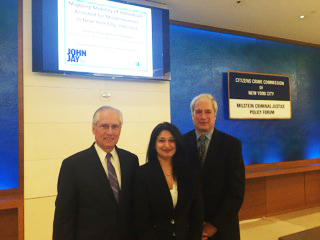
June 7, 2016, New York, NY – John Jay College of Criminal Justice today released a report on the relationship between offending behavior and location to better understand the phenomenon of mobility for misdemeanor arrests. The study, Mapping Mobility of Individuals Arrested for Misdemeanors in New York City, 2006-2014, aims to inform the NYPD, other criminal justice agencies, social service providers, and community organizations on the geographical allocation of resources for better law enforcement, crime prevention, and community supervision.
President Jeremy Travis and Professor of Psychology Preeti Chauhan presented key findings of the report at a Citizens Crime Commission breakfast this morning.
“A focus on these issues of mobility presents interesting policy questions for the criminal justice system,” said President Travis. “For example, this analysis can inform the development of strategies for neighborhood policing. Given the mobility of precinct residents who are arrested elsewhere, and the high levels of arrests occurring from non-residents, the philosophy of neighborhood policing might be adapted to reflect these realities.”
“These analyses suggest a remarkable amount of mobility among individuals arrested for misdemeanors” said Professor Chauhan. “In, 2014, almost half of all individuals arrested for a misdemeanor in New York City were outside their home precinct.”
Key findings from the report are as follows.
- In 2014, almost half (48.5 percent) of all individuals arrested for a misdemeanor were arrested outside of their home precinct. Furthermore, if an individual was arrested outside of their home precinct, the arrest most often occurred in an adjacent precinct.
- In 2014, almost half (44.6 percent) of all individuals arrested for a misdemeanor in Manhattan did not live in that borough. For other boroughs, individuals arrested there were much more likely to live in that borough: the Bronx (80.8 percent), Brooklyn (83.0 percent), Queens (73.3 percent), and Staten Island (87.0 percent).
- In 2014, among home precinct arrests, the most frequent charges were crimes against a person (24.5 percent) and offenses related to marijuana (16.8 percent).
- In 2014, of arrests that occurred outside the home precinct, the most frequent charges were property and theft-related (17.7 percent) and vehicle and driving-related (17.2 percent).
Manhattan Executive Assistant District Attorney for Strategic Initiatives Nitin Savur said: “As our Office’s pioneering Crime Strategies Unit has found, one of the best tools to fight and prevent crime is data. We’ve developed detailed maps, going block by block through Manhattan neighborhoods to identify hot spots and crime drivers. Leveraging this data enables us to better focus our resources and achieve safer, fairer criminal justice outcomes. I thank John Jay for this important report, which will guide our proactive work to reduce crime beyond today’s historic lows.”
“As with their previous reports, President Travis and Professor Chauhan’s latest analysis will provide important data that will help further the criminal justice policy dialogue in New York City,” said Richard Aborn, Citizens Crime Commission President. “Understanding whether offenders are committing crimes in the precinct they live or are traveling from other precincts, counties, or even states to commit crimes will undoubtedly have an impact on how the justice system responds to low-level offending, including where to invest resources for diversion and rehabilitative programming.”
Greg Berman, Director of the Center for Court Innovation, noted: "This is an impressive piece of research that makes a number of important contributions to our field. It provides a snapshot of a justice system at a moment of change, as it responds to concerns about over-enforcement and over-incarceration. Just as important, it offers a roadmap for those who are interested in promoting the idea of community justice, highlighting the places where there is the greatest need for new responses to misdemeanor crime."
The complete data analyses are documented in the report which is available here.
With funding by the Laura and John Arnold Foundation, this is the fourth report prepared by the Misdemeanor Justice Project (MJP), a research initiative at John Jay College headed by Professor Chauhan that includes faculty, graduate students and staff.
The previous three reports of the MJP, Trends in Misdemeanor Arrests in New York, The Summons Report: Trends in the Issuance and Disposition of Summonses in New York City, and Tracking Enforcement Rates in New York City were released in 2014 and 2015 and examined demographic trends in charges, dispositions, and sentences for misdemeanor arrests and C-summonses as well as the rise and fall of enforcement actions that bring the public in contact with police.
The Citizens Crime Commission of New York City is a non-partisan non-profit organization working to make criminal justice and public safety policies and practices more effective through innovation, research, and education. In the last three decades, the Crime Commission has been a leader on key issues such as: increasing the size of the NYPD, expanding the use of DNA evidence in crime fighting, creating innovations that reduce juvenile crime, developing interventions against gun violence and illegal gun crime, and highlighting the changing nature of the threat of terrorism. For more information, visit www.nycrimecommission.org.
About John Jay College of Criminal Justice: An international leader in educating for justice, John Jay College of Criminal Justice of The City University of New York offers a rich liberal arts and professional studies curriculum to upwards of 15,000 undergraduate and graduate students from more than 135 nations. In teaching, scholarship and research, the College approaches justice as an applied art and science in service to society and as an ongoing conversation about fundamental human desires for fairness, equality and the rule of law. For more information, visit www.jjay.cuny.edu.



